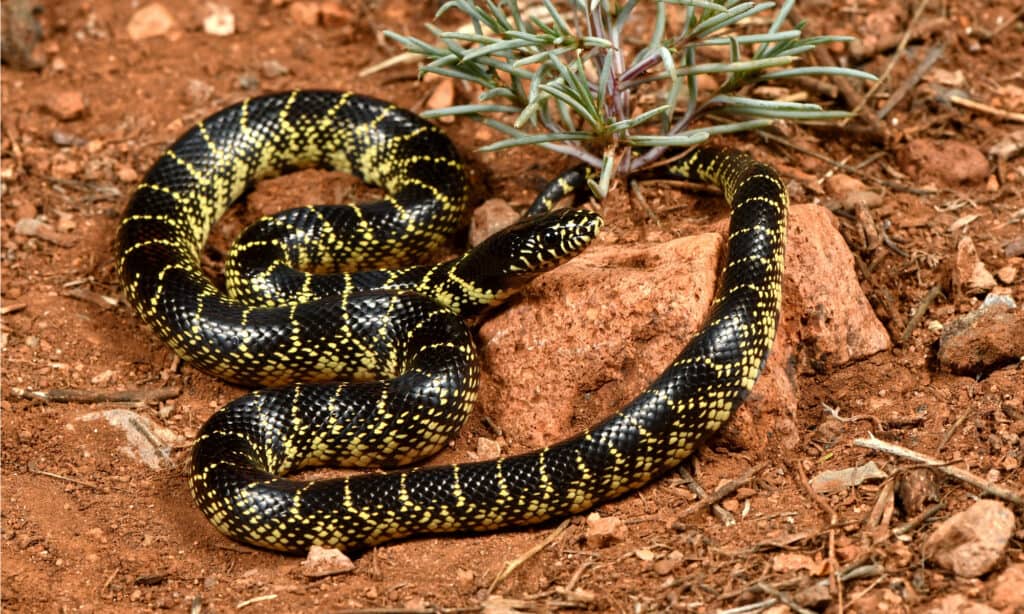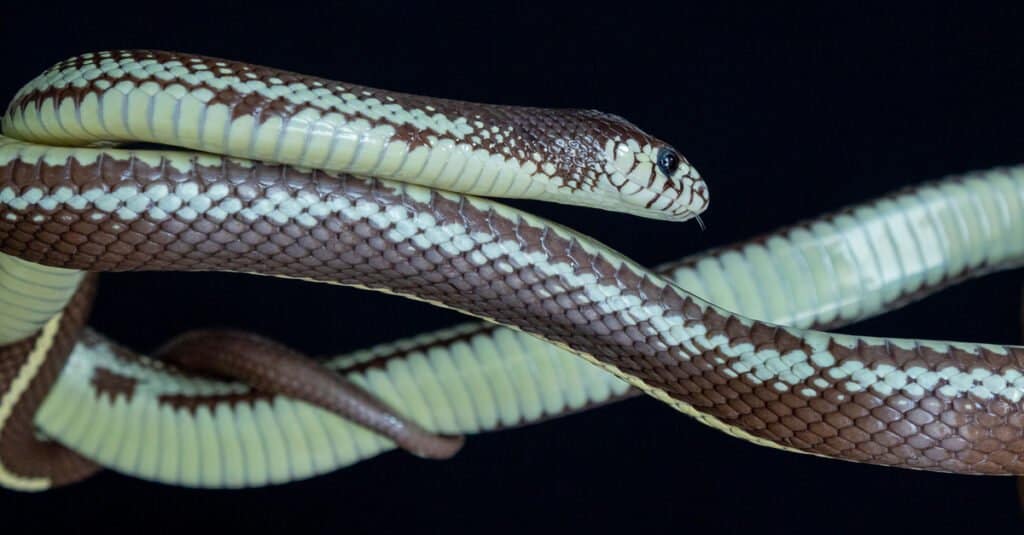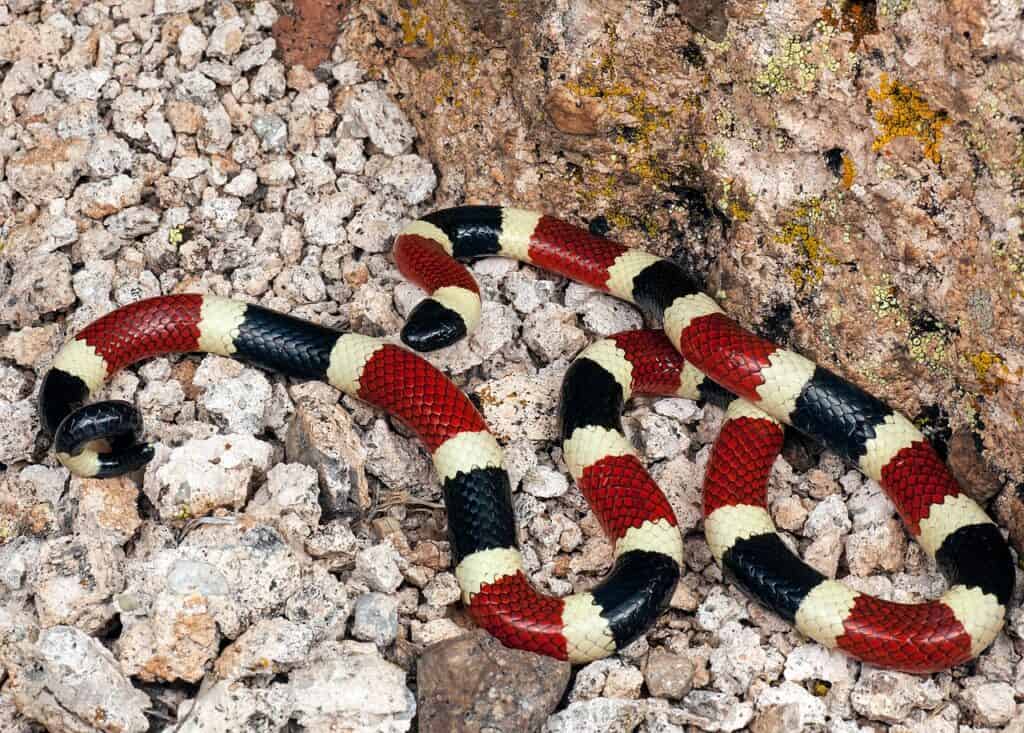Discover 5 Black and White Snakes in Arizona - AZ Animals
More Great Content:
↓ Continue Reading To See This Amazing Video
As you may already know, Arizona is home to many types of snakes, some of which can be dangerous. Black and white snakes are no exception – while some are harmless, others can deliver a painful bite that may require medical care. That's why it's so important to be able to identify these snakes. If you see a snake with black and white coloring on its body, the best thing to do is to stay away from it or call for professional help.
With that said, here are some things you should know about common black and white colored snakes you can find in Arizona:
1. The Desert Kingsnake (Lampropeltis splendid)

©Jon Bolton/Shutterstock.com
The desert kingsnake is a small to medium-sized snake, averaging 48 inches or 122 centimeters long. But individuals can range in size from 32 to 64 inches or 81 to 163 centimeters. The desert kingsnake is black or dark brown with light-colored bands running the size of its body. These bands are usually yellow, cream, or white but can also be orange or red, depending on the snake.
Desert kingsnakes are carnivorous reptiles that feed on small mammals, such as rodents and lizards. They will also consume birds, eggs, and insects if available. In captivity, desert kingsnakes can be fed a diet of live or frozen and thawed mice or rats. But when keeping a desert kingsnake as a pet, it is crucial to offer a variety of sizes to maintain a healthy weight and avoid obesity.
The desert kingsnake is usually found in various habitats, extending from the southwestern United States into northern Mexico. In the United States, they are most commonly found in arid or semi-arid regions of Arizona, California, Colorado, Nevada, New Mexico, Oklahoma, Texas, and Utah. In Mexico, they are found in Chihuahua, Coahuila, Durango, Nuevo Leon, and Zacatecas.
Black and White Snakes in Arizona: The Desert Kingsnake Features
Desert kingsnakes typically inhabit areas with loose sand or gravel substrate and plenty of hiding places such as rocks or wood debris. They can also be found in agricultural areas and around human habitation. The desert kingsnake is also known for its hunting skills, as it can find and capture prey even in the harshest conditions.
These fascinating desert kingsnakes are also excellent swimmers and climbers, making them very difficult for predators to catch. Desert kingsnakes often coil up to conserve body heat when sleeping. During periods of extreme cold, these snakes will enter into a state of torpor to survive. Tophor is a period of reduced metabolic activity used to conserve energy, similar to hibernation.
During the breeding season, male desert kingsnakes will often compete with one another to mate with a nearby female. The competition winner will then wrap his body around the female and fertilize her eggs.
2. Arizona Black Rattlesnake (Crotalus cerberus)

©Scott Delony/Shutterstock.com
The Arizona black rattlesnake is commonly black, with white or light-colored spots and patterns on its body. This snake is typically found in the southwestern United States and can grow up to 5 feet long. It is important for Arizona residents and visitors to be able to recognize the Arizona black rattlesnake, as it is venomous, and its bite can be fatal to humans if not treated immediately.
The Arizona black rattlesnake is a carnivore that primarily feeds on small mammals such as mice, rats, and squirrels. It will also eat lizards, birds, and even other snakes. This snake uses heat-sensing pits between its eyes and nostrils to detect warm-blooded prey. Once its target is within range, the snake will strike with lightning speed, injecting venom into the victim through long, hollow fangs. The venom quickly breaks down tissue and blood cells, causing paralysis and death.
Where is the Arizona Black Rattlesnake found?
This snake is commonly found in Arizona, New Mexico, Colorado, Utah, western Texas, and northern Mexico. The Arizona black rattlesnake typically inhabits desert regions with rocky terrain and plenty of hiding places. However, this snake can sometimes be found near water sources in grassland areas as well. The Arizona black rattlesnake usually prefers to stay hidden during the day and comes out to hunt for prey at night.
When threatened, the Arizona black rattlesnake will rapidly coil up and shake its tail to warn potential predators that it is ready to strike. If necessary, it will not hesitate to bite in self-defense.
If you ever encounter an Arizona black rattlesnake in the wild, there are some important things to remember. First and foremost, do not approach the snake. These creatures are dangerous and can cause severe injury or even death if they feel threatened or cornered. If you must go near the snake, use extreme caution and give it plenty of space. Thankfully, this snake generally avoids confrontation with humans. Most encounters with this snake result in the rattlesnake retreating or warning the human by shaking its tail, producing a rattling sound.
If you see a black rattlesnake while hiking or camping, be sure to tell your fellow hikers or campers so that they can avoid the area. It is also essential to report any sightings of these snakes in busy areas to authorities so that they can take steps to protect people and pets in the area.
3. Black and White Snakes in Arizona: California Kingsnake (Lampropeltis getula californiae)

©Murilo Mazzo/Shutterstock.com
First and foremost, the California kingsnake is known to be a gorgeous specimen. They typically measure between 3-4 feet, but individuals have been known to grow up to 6 feet long! These snakes are black in color with white stripes. They're truly a sight to behold! But beyond their physical appearance, California kingsnakes are also fascinating creatures. They're great swimmers and climbers, known for being very docile snakes – they're even kept as pets!
California kingsnakes are carnivorous and primarily eat small mammals, such as rodents. They will also eat lizards, birds, and animal eggs. Interestingly, these snakes are also known to eat other snakes, including venomous snakes. Kingsnakes hunt by slithering through their habitat and actively searching for prey. When they find an animal, they will strike quickly to subdue it. Once the prey is captured, the kingsnake will coil its body around it and constrict tightly until the animal stops breathing. The snake will then uncoil and swallow its prey, starting with the head.
California Kingsnake Features
The California kingsnake is found in various habitats throughout its range, including parts of California, Nevada, Utah, and Arizona. This snake prefers rocky or sandy soils with plenty of cover in dense vegetation. They can often be found near streams or other bodies of water occasionally. As stated, the California kingsnake is an excellent climber, often found basking on rocks or branches in sunny areas.
If you see a California kingsnake in the wild, the best thing to do is admire it from afar. Do not attempt to catch or handle the snake; they can be aggressive when feeling threatened. If you must move the snake, use a long stick or pole to guide it off the path or away from children and pets.
4. Arizona Coral Snake (Micruroides euryxanthus euryxanthus)

©CC BY-SA 2.0
The Arizona coral snake is a small to medium-sized snake that can grow up to 13 to 21 inches or 33 to 53 centimeters long. It's characterized by its red, orange, black, and white colored bands throughout its body. This coloration is what makes the Arizona coral snake so unique and beautiful. It's also worth mentioning that the Arizona coral snake has similar coloration to nonvenomous snakes like the Arizona coral snake mimic and the scarlet snake.
The Arizona coral snake is a carnivore whose diet consists mainly of small lizards and rodents. It typically hunts by lying in wait for its prey, then striking quickly to subdue it. Once its prey is stopped, the coral snake will coil around it and constrict until it suffocates. The coral snake will typically eat 1 to 2 times per week, but this can vary depending on the availability of food and the size of the meals.
The snake is commonly native to the southwestern United States, specifically Arizona, New Mexico, and Texas, and typically inhabits dry desert areas with rocky terrain and sparse vegetation. It can also occasionally be found in grasslands and woodlands near streams or other bodies of water.
Arizona Coral Snake Features
The Arizona coral snake is primarily active hunting at night but can also be seen during the day during cooler months and days. The snake often retreats underground during hot summer days to escape the harsh heat.
In breeding season, the male and female coral snakes will coil around each other in a process often referred to as "caudal entwining." After successful mating, the female will lay a clutch of eggs which she will incubate for about two months before they hatch.
The Arizona coral snake is not aggressive and usually only bites if it feels threatened or in danger. Unfortunately, this snake can also be very dangerous when threatened. The venom of the Arizona coral snake is highly toxic and can be deadly if not treated immediately.
5. Black and White Snakes in Arizona: Sonoran Mountain Kingsnake (Lampropeltis pyromelana)

©Matt Jeppson/Shutterstock.com
The Sonoran mountain kingsnake boasts vibrant red or orange coloring with black and white bands running down their bodies. Not only are they beautiful, but they're also quite fascinating creatures. They're known for being very docile and easy to handle, which makes them popular pets. They're also great escape artists, so keeping a close eye on them in their enclosures is essential.
The Sonoran mountain kingsnake is a carnivorous snake whose diet consists mainly of meat. This snake typically preys on small mammals such as rodents and lizards, but it will also eat birds and eggs if given the opportunity. The Sonoran mountain kingsnake is generally a sit-and-wait predator, meaning that it will often wait patiently for prey to come within striking distance before attacking. However, during the breeding season, these snakes may become more active and may actively hunt their prey.
Black and White Snakes in Arizona: Sonoran Mountain Kingsnake
These snakes are primarily found in the Sonoran Desert, which spans parts of Arizona, California, and Mexico. They are most commonly found in desert scrub and grassland habitats in Arizona. The Sonoran mountain kingsnake is a very adaptable snake and can thrive in a wide range of different habitat types. However, these habitats have one thing in common: they are all relatively warm and dry environments where it can easily find food.
While this snake is typically a shy and docile creature, it can be aggressive if provoked or scared. It's a non-venomous constrictor, meaning it will kill its prey by wrapping itself around it and squeezing it tightly until the prey suffocates. It's also an opportunistic feeder, which means it will hunt whenever the opportunity arises, whether day or night.
Female Sonoran mountain kingsnakes usually give birth to litters of between 3 and 6 eggs, which will hatch after approximately 80 days. However, litter sizes can vary depending on the size and health of the mother snake. Breeding typically occurs in late spring or early summer. Interestingly, Sonoran mountain kingsnakes have been observed exhibiting communal nesting behavior, where multiple females lay their eggs in the same nest site and help protect each other's eggs.
Comments
Post a Comment